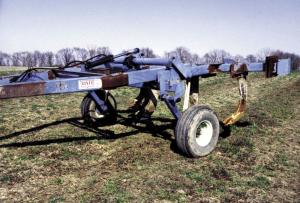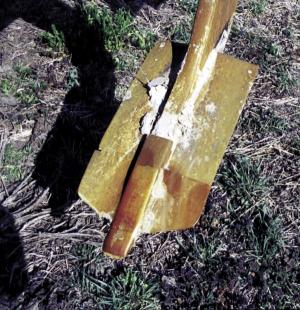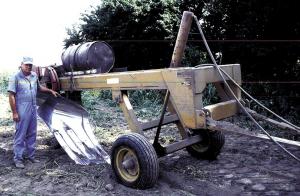"Deep" Spading Loosens Soil Pan, Boosts Crop Yields
Jim Bauer tried deep ripping but it wasn't the answer to the soil problems he faced on his Worden, Ill., farm. But when his friend and neighbor Ross Lay, Litchfield, Ill., got good yield increases from a home-built deep ripper that he calls a spader (FARM SHOW Vol. 22, Issue 3, page 32), Bauer figured it was worth a try, too.
After all, Lay's soils were similar to his, so he figured the problems were bound to be similar. "I'm farming windblown soils that are 18 in. to 2 ft. thick over the top of some ancient topsoil," he explains.
Lay built his deep ripping "spader" by fastening 4-ft. long sections of road grader blade lengthwise to the bottom of his ripper shanks. With a 350 hp tractor, he pulls two of these spader shanks spaced 5 ft. apart, running at depths of 26 to 32 in. He claims it gives him a 30 bu. boost in corn yields and bumps soybean yields the year following by a good 6 bu.
While he was considering how to make one, he attended a soil symposium on Lay's farm where he met Bill Dieterich, founder of DMI and inventor of the DMI Turbo Tiger and other deep-tilling tillage tools. Bauer says he discussed the idea with Dieterich, who then offered him advice and also sold him parts and steel he could use in making his own spader.
"He sold me the experimental prototype used to perfect the Turbo Tiger. It had the DMI logo on it, but also said Šexperimental' on the side of the frame," Bauer recalls. Most importantly, it had the shanks and sturdy toolbar Bauer was looking for.
Bauer left the five shanks on the bar and lengthened the center and two outside shanks to 4 ft., so they would go up to 30 in. deep into the soil and still have plenty of clearance when working in undisturbed corn stalks.
He left the Turbo Tiger ripper points in place on all five shanks. On the three shanks he lengthened, he welded sections of 10-in. wide hardened steel grader blade, with the leading edge angled slightly down to the tip, which he left 3 in. longer and lower still than the grader blade. "The first year, I tried making my own shoes, but I wasn't satisfied with them because they wore out so fast. The second year I replaced them with the hardened steel grader blade and I haven't had to replace them since," he says.
"This design pulls the shank into the soil, so I don't need any additional weight to make it go down. In fact, I have to use the gauge/transport wheels to keep it at the right depth," he says.
The shanks, made of 1 1/2-in. solid steel bar, had to be widened at the top as well. "I had to add a half-moon section with a radius of about 6 in. to the front of the shanks at the top, in order to change the shear point when running the shanks that deep. Before I widened them at the top, the shear bolts would break as soon as the shanks went into the ground," he says. "Originally, the distance between the shear and the anchor bolts was 7 in. I lengthened that to 12 in. before I finally got it right," he says. Now the shear bolts only break when he hits something harder than the clay pan he's breaking up.
Bauer uses his spader in the fall on every acre he intends to plant to corn in his three-year corn-soybean-wheat/soybean doublecrop rotation. He sets the depth so the spader shanks run 20 to 24 in. deep most of the time. The two original factory shanks between the three spaders cut in at 10 to 14 in.
He says the cost of converting the old Turbo Tiger into a deep spader was minimal. "Not counting the cost of the machine I bought from Dieterich, it was probably under $500," he says.
He's used his deep spader for several years. He says there's a yield advantage in every crop year, with corn yields 20 bu. or so higher, depending on the year.
There might be one disadvantage to this type of deep ripping. "Last year, when it was dry all year but then wet in the fall, the soil stayed loose. When we tried to get through the wet fields with the combine in the fall of 2001, it was like there was no bottom under it and we had to use the big tractor for pulling out the combine as well as for spading," he says.
Conta

Click here to download page story appeared in.
Click here to read entire issue
Deep Spading Loosens Soil Pan Boosts Crop Yields SUBSOILERS Subsoilers 58n Jim Bauer tried deep ripping but it wasn t the answer to the soil problems he faced on his Worden Ill farm But when his friend and neighbor Ross Lay Litchfield Ill got good yield increases from a home-built deep ripper that he calls a spader FARM SHOW Vol 22 Issue 3 page 32 Bauer figured it was worth a try too After all Lay s soils were similar to his so he figured the problems were bound to be similar I m farming windblown soils that are 18 in to 2 ft thick over the top of some ancient topsoil he explains Lay built his deep ripping spader by fastening 4-ft long sections of road grader blade lengthwise to the bottom of his ripper shanks With a 350 hp tractor he pulls two of these spader shanks spaced 5 ft apart running at depths of 26 to 32 in He claims it gives him a 30 bu boost in corn yields and bumps soybean yields the year following by a good 6 bu While he was considering how to make one he attended a soil symposium on Lay s farm where he met Bill Dieterich founder of DMI and inventor of the DMI Turbo Tiger and other deep-tilling tillage tools Bauer says he discussed the idea with Dieterich who then offered him advice and also sold him parts and steel he could use in making his own spader He sold me the experimental prototype used to perfect the Turbo Tiger It had the DMI logo on it but also said Šexperimental on the side of the frame Bauer recalls Most importantly it had the shanks and sturdy toolbar Bauer was looking for Bauer left the five shanks on the bar and lengthened the center and two outside shanks to 4 ft so they would go up to 30 in deep into the soil and still have plenty of clearance when working in undisturbed corn stalks He left the Turbo Tiger ripper points in place on all five shanks On the three shanks he lengthened he welded sections of 10-in wide hardened steel grader blade with the leading edge angled slightly down to the tip which he left 3 in longer and lower still than the grader blade The first year I tried making my own shoes but I wasn t satisfied with them because they wore out so fast The second year I replaced them with the hardened steel grader blade and I haven t had to replace them since he says This design pulls the shank into the soil so I don t need any additional weight to make it go down In fact I have to use the gauge/transport wheels to keep it at the right depth he says The shanks made of 1 1/2-in solid steel bar had to be widened at the top as well I had to add a half-moon section with a radius of about 6 in to the front of the shanks at the top in order to change the shear point when running the shanks that deep Before I widened them at the top the shear bolts would break as soon as the shanks went into the ground he says Originally the distance between the shear and the anchor bolts was 7 in I lengthened that to 12 in before I finally got it right he says Now the shear bolts only break when he hits something harder than the clay pan he s breaking up Bauer uses his spader in the fall on every acre he intends to plant to corn in his three-year corn-soybean-wheat/soybean doublecrop rotation He sets the depth so the spader shanks run 20 to 24 in deep most of the time The two original factory shanks between the three spaders cut in at 10 to 14 in He says the cost of converting the old Turbo Tiger into a deep spader was minimal Not counting the cost of the machine I bought from Dieterich it was probably under $500 he says He s used his deep spader for several years He says there s a yield advantage in every crop year with corn yields 20 bu or so higher depending on the year There might be one disadvantage to this type of deep ripping Last year when it was dry all year but then wet in the fall the soil stayed loose When we tried to get through the wet fields with the combine in the fall of 2001 it was like there was no bottom under it and we had to use the big tractor for pulling out the combine as well as for spading he says Conta
To read the rest of this story, download this issue below or click
here to register with your account number.









